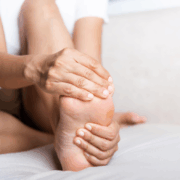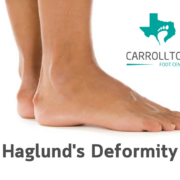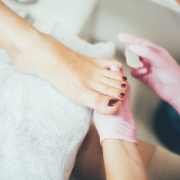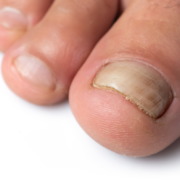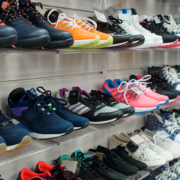Is My Foot Lying to Me? Phantom Feelings from Nerve Damage
Ever feel a weird burning, crawling, or pinching in your foot and swear your sock is bunched up, only to find nothing there? Dr. Naghmeh Lilly Khavari hears reports of these phantom sensations all the time, and they are often the clearest sign of neuropathy, which is a condition that affects how the nerves communicate. Let’s discuss some of the most common sensations in detail.
Common Symptoms of Nerve Damage in the Feet
Your nerves are like the body’s wiring system. When they get damaged, compressed, or irritated by conditions like diabetes, tarsal tunnel syndrome, or a neuroma, they start to short-circuit.
Here are some of the weirdest and most common phantom sensations your feet might experience:
The Stuck Pebble Sensation
- What it feels like: You constantly feel like you are standing on a marble, a small rock, or a wrinkled sock, usually right under the ball of your foot between your toes.
- The reality: There’s nothing actually there. This feeling is caused by a Morton’s neuroma, which is a thickening of nerve tissue, and makes the nerve itself take up space and feel like a foreign object when compressed.
Pins and Needles
- What it feels like: A crawling, prickling, or stinging sensation, like a thousand tiny needles that comes on for no reason.
- The reality: This is paresthesia, and it means the nerve signals are going haywire, often caused by minor nerve compression or early-stage neuropathy.
The Burning/Icy Effect
- What it feels like: Your feet feel intensely hot, as if they are perpetually on fire or submerged in scalding water, or sometimes they feel intensely icy and cold.
- The reality: This is a classic sign of neuropathic pain. The damaged nerves are wrongly interpreting temperature signals.
The Itch You Can’t Scratch
- What it feels like: An intense, sometimes debilitating itching sensation, often deep inside the skin or muscles, that you can’t scratch away with any relief.
- The reality: There is no rash or external cause. This happens when damaged nerves misfire, and your brain translates the abnormal signal into an unrelenting itch.
Extreme Sensitivity
- What it feels like: Normally, non-painful stimuli become excruciating. The slight brush of a pant leg can feel agonizing.
- The reality: This is called allodynia. Pain receptors become severely oversensitive.
The Muscle Jump
- What it feels like: You might notice subtle, spontaneous, quick twitching in the muscles of your foot or calf, even when you’re resting.
- The reality: This is fasciculation, which is minor, involuntary muscle contractions often associated with nerve irritation or damage.
Disclaimer: We’ve all had these sensations from time to time. But if you are experiencing many of these in tandem frequently, it could be a sign of neuropathy. Visit us for a consultation!
Consult with Board-certified podiatrist Dr. Naghmeh Lilly Khavari, a knowledgeable professional who is dedicated to her patients in Denton, Dallas, and Collin Counties. Dr. Khavari treats a wide range of conditions, from ingrown toenails to foot and ankle injuries. Call Carrollton Foot Center’s office (located in Carrollton, Texas) at (469)-998-3668 to schedule your first appointment today!

